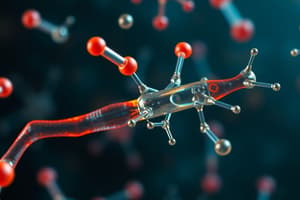Podcast
Questions and Answers
What are the two well-documented categories under which key symptoms of ADHD fall?
What are the two well-documented categories under which key symptoms of ADHD fall?
- Attentional capacity and distractibility
- Inattention and impulsivity
- Inattention and hyperactivity (correct)
- Hyperactivity and impulsivity
Which type of attention deficit in children with ADHD is described as the inability to sustain attention, particularly for repetitive, structured, and less enjoyable tasks?
Which type of attention deficit in children with ADHD is described as the inability to sustain attention, particularly for repetitive, structured, and less enjoyable tasks?
- Selective attention
- Attentional capacity
- Distractibility
- Sustained attention/vigilance (correct)
What type of behavior is characterized by fidgeting and difficulty staying seated in children with ADHD?
What type of behavior is characterized by fidgeting and difficulty staying seated in children with ADHD?
- Emotional impulsivity
- Impulsivity
- Hyperactivity (correct)
- Cognitive impulsivity
Which of the following is NOT a characteristic of cognitive impulsivity in children with ADHD?
Which of the following is NOT a characteristic of cognitive impulsivity in children with ADHD?
What do behavioral impulsivity and emotional impulsivity include in children with ADHD?
What do behavioral impulsivity and emotional impulsivity include in children with ADHD?
In children with ADHD, what is the inability to control immediate reactions or to think before acting referred to as?
In children with ADHD, what is the inability to control immediate reactions or to think before acting referred to as?
What is the focus of Parent Management Training (PMT)?
What is the focus of Parent Management Training (PMT)?
Which training is aimed at helping children appraise and interact with situations in a prosocial manner?
Which training is aimed at helping children appraise and interact with situations in a prosocial manner?
What does Multisystemic Therapy (MST) target in teens?
What does Multisystemic Therapy (MST) target in teens?
What is key to preventing conduct problems in children according to the text?
What is key to preventing conduct problems in children according to the text?
Which program has been designed to prevent the development of antisocial behavior in high-risk children?
Which program has been designed to prevent the development of antisocial behavior in high-risk children?
In which chapter do depressive and bipolar disorders get discussed?
In which chapter do depressive and bipolar disorders get discussed?
Which three factors are important to consider when examining antisocial behaviors in children?
Which three factors are important to consider when examining antisocial behaviors in children?
What are the three key dimensions of Oppositional Defiant Disorder (ODD) in children?
What are the three key dimensions of Oppositional Defiant Disorder (ODD) in children?
What is the key difference between childhood-onset and adolescent-onset Conduct Disorder (CD)?
What is the key difference between childhood-onset and adolescent-onset Conduct Disorder (CD)?
What percentage of children with Conduct Disorder (CD) are estimated to later develop Antisocial Personality Disorder (APD)?
What percentage of children with Conduct Disorder (CD) are estimated to later develop Antisocial Personality Disorder (APD)?
What are the key characteristics of the 'callous and unemotional' (CU) interpersonal style associated with a subgroup of children with Conduct Disorder?
What are the key characteristics of the 'callous and unemotional' (CU) interpersonal style associated with a subgroup of children with Conduct Disorder?
What are some common cognitive and verbal deficits associated with Conduct Disorder in children?
What are some common cognitive and verbal deficits associated with Conduct Disorder in children?
What is the most successful treatment for depression in adolescents?
What is the most successful treatment for depression in adolescents?
What is the main focus of Interpersonal Psychotherapy for Adolescent Depression (IPT-A)?
What is the main focus of Interpersonal Psychotherapy for Adolescent Depression (IPT-A)?
What is the difference between Bipolar 1 and Bipolar 2 disorders?
What is the difference between Bipolar 1 and Bipolar 2 disorders?
What is the prevalence of Bipolar Disorder in youths?
What is the prevalence of Bipolar Disorder in youths?
What is considered a common comorbidity with Bipolar Disorder?
What is considered a common comorbidity with Bipolar Disorder?
What is believed to be a cause of Bipolar Disorder in children?
What is believed to be a cause of Bipolar Disorder in children?
How can depression impact a child's academic functioning?
How can depression impact a child's academic functioning?
How does depression affect a child's cognitive biases and distortions?
How does depression affect a child's cognitive biases and distortions?
What is the typical age of the first suicide attempt for youth with depression?
What is the typical age of the first suicide attempt for youth with depression?
According to the psychodynamic theory, why don't children and adolescents become depressed?
According to the psychodynamic theory, why don't children and adolescents become depressed?
What is the key focus of the cognitive theory of depression?
What is the key focus of the cognitive theory of depression?
According to the socio-environmental theory, what model is used to explain the onset and course of depression?
According to the socio-environmental theory, what model is used to explain the onset and course of depression?
Flashcards are hidden until you start studying




